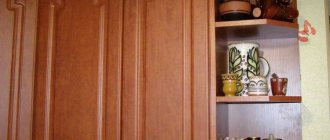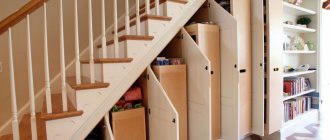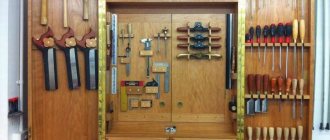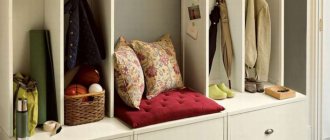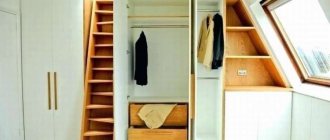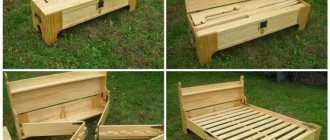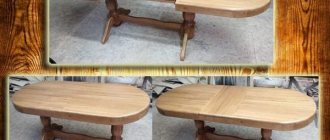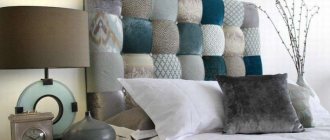DIY wardrobe for children's room
Need a new wardrobe for your children's room ? Don't rush to the store, look at 15 wonderful examples of various models that you can easily make with your own hands. There is no right or wrong to designing children's furniture, what you do yourself for your child will always be the best.
Children don't think "my closet has to match the color of the wallpaper," they love bright, colorful aspects that capture their imagination. Keep this in mind, and you will not be mistaken when choosing which wardrobe to make for the nursery . Of course, there are few examples in this article, but these instructions are more for inspiration. I hope you will find some useful tips, and the drawings and step-by-step photos presented in the material will help you.
Step-by-step instructions for making a cabinet-house
Step 1. Draw it yourself or find on the Internet a sketch of a cabinet-house with suitable dimensions.
Sketch of a cabinet-house
Addition to the sketch
At the same time, pay attention to your initial conditions: the age and gender of the child, the number of children, the size of the children's room, the availability of special tools and equipment, practical experience in making furniture and financial capabilities.
Calculate the approximate amount of lumber, hardware and fittings.
Practical advice. Always buy hardware with a reserve; it is impossible to provide for everything at the stage of independent design.
Hardware
Choose the safest methods of fixation; there should be no sharp edges, burrs, etc. on the surfaces of the children's closet. Do not use fixes and minifixes. The fact is that these elements have technological holes that are closed with plastic plugs. Curious children will definitely pick out the plugs and gain access to the metal eccentrics. Then how lucky you are: whether they will be able to unscrew the eccentric and destroy the cabinet or not - no one can predict. But there is a firm belief that the consequences of dismantling the cabinet will be very sad.
For the cabinet we chose 10 mm thick plywood, which is quite sufficient for such loads. The area of one sheet is 2.3 m2, we need two. The dimensions were calculated after selecting the cabinet-house model. To make work easier, Sh1 grade plywood has one side sanded at the factory. In the same store you need to buy paint, brushes and the missing tools.
Plywood
Step 2. Make details and draw a cutting plan. If you plan to order cutting from specialized companies, then they have programs that make up the optimal plan for cutting the board. Professionals, by the way, strongly advise against cutting yourself.
If you do not have a workshop with good woodworking machines, then there are great risks of sawing waste, and the cost of damaged material far exceeds the price of sawing services. To the financial losses we must also add the loss of time and nerve cells. Another problem is that sawing furniture panels is accompanied by a lot of noise; not all neighbors will be grateful for such inconvenience.
If you buy materials from large construction stores, many of them provide this service to their customers for free - a great opportunity to save money.
Sawing can be ordered from most large hardware stores.
And one last thing. The more precise the parts, the easier their assembly is and the better the quality of the cabinet-house. And this design has a lot of constituent elements, some of them are large and some are quite small. Correcting mistakes later is very time-consuming and unpleasant.
Step 3. Bring the parts home, check their completeness and dimensions. Prepare your workbench for assembly. If you have a country house, great, it’s easier to work there.
Practical advice. It is not worth cutting very small parts in the store. Firstly, employees perform such work with great reluctance. Secondly, during assembly there may always be a desire to make certain changes; you will have to change the number and sizes of some parts.
Step 4. Mark out small elements, constantly check the list or sketch. Don't rush, if the cutting conditions are incorrect, a lot of chips will appear on the edges of the plywood. Removing them is time-consuming and difficult, and leaving them on children's furniture is strictly prohibited.
Marking small elements
Drawing cutting lines according to the sketch
Step 5. Very carefully cut off the missing pieces. The plywood must be pressed to the table with clamps; you can work with an ordinary electric jigsaw. If you don’t have clamps, you’ll have to call a friend for help; cutting is very inconvenient for him. You have to hold the plywood with one hand and use the jigsaw with the other. The pressing force changes, the workpiece can rotate, and this is either a defect or a breakage of the tool saw.
Cutting parts with a jigsaw
Children's wardrobes have a large number of openings: windows and doors, patterns and ornaments. Cutting them out is quite difficult and troublesome; you always need to pre-drill holes, otherwise you will not be able to get the saw into the right place. The process will be much simpler if you prepare not one hole, but several along the entire perimeter of the part.
Drilling followed by sawing
Plywood is drilled much easier than sawed; this algorithm of actions makes it possible to reduce the time for preparing elements and at the same time significantly improve their quality.
Step 6. Using sandpaper, carefully remove sharp corners and burrs. Process each part at least twice; after the first, there are often gaps. Don’t rely on your attentiveness; long-term work sharply worsens it.
Careful sanding
Young children can injure not only their hands, but also their faces, and such injuries leave marks for life. Always remember this.
Step 7. Start assembling the cabinet-house. For fixation, you can use nails or screws. The first hardware is preferable, it is faster to work with them, and the heads are securely hidden in the plywood without preliminary drilling.
Assembling a cabinet-house
First, assemble the supporting frame, this structure will be subject to significant forces, pay due attention to the strength of the connection of the supporting units. Then install partitions in it, make a roof and other elements.
Side walls
Back wall
Partitions and roof
Individual small decorative items of the cabinet can be fixed with liquid nails, this is much easier, and does not have any effect on the quality.
Super strong glue
Step 8: Paint the closet.
Dye
Don’t be afraid to involve children in this work, let them take an active part in creating furniture. You can paint the base of the cabinet and let the children create their own drawings on it. Remember that, in principle, there are no ugly children's drawings; evaluate them only from this position. At least two layers of paint are applied to the surface of the plywood; if the pile rises, it should be removed with fine sandpaper.
Painting the house
Ready-made wardrobe
Show the children places for clothes and toys, and lay them out with them for the first time. Don’t forget to praise your child for his efforts and skill, this will give him confidence in his abilities and will be a very effective incentive for further cleaning the children’s room on his own.
The walls of the house are decorated with toys
Additionally installed LED lighting
How to make lighting in a dollhouse
And one last thing. Know that industrial children's furniture undergoes very complex state certification for many characteristics. Such stringent requirements exist for a reason, but to protect children’s health. Do the same strict control of all safety parameters for your furniture.
Types of cabinets
For dresses. This type consists of side parts, bottom, top part, facade. The inside is equipped in such a way that things hang on hangers; it has no shelves, or their number is reduced to a minimum. The door opens wide.
Closet. An improvement on the previous type. The main difference is the sliding door system, which can be built-in (without side parts or without bottom).
Option for the bedroom. This type is not the main one, it includes a set of clothes for tomorrow, it contains a minimum number of shelves for towels, shoes, and trousers.
Multi-door wardrobes. They have several departments with rods, many shelves and drawers. The depth is no more than 60 centimeters, the width is 10 centimeters less than the depth.
View with end rods. This means a built-in hanger in a structure not exceeding a depth of 400 millimeters.
It would be wrong if I didn’t notice that the closet is also divided into different shapes - corner or flat structures. Now, having understood a little about the types of structures, we move on to the next stage - choosing the material for making the cabinet.
In the modern world there are a lot of options, for every taste and color. Basically, solid wood, chipboard, and MDF are used for this type of furniture. For finishing wood, you can use laminated, laminated methods.
What materials can it be made from?
Almost everyone has boxes of shoes or kitchen appliances collecting dust in their pantry for a long time. Without thinking that this “junk” might one day be useful, they throw it away. But it is precisely this that can become the basis for designer items and original works.
Such creations include a wardrobe for doll things.
It can be made from simple materials:
- cardboard;
- boxes;
- newspapers;
- paper;
- matchboxes.
And to decorate products, experienced craftsmen use acrylic paint, decoupage napkins, fabric and colored paper.
Preparation of elements and accessories
The parts from which the cabinet is assembled are cut from chipboard sheets. When marking the sheet, it is necessary to take into account the cutting width of the saw (approximately 3 mm) so that the parts do not turn out smaller than required. It is quite difficult to independently cut a sheet with a hacksaw or jigsaw, so it is better to order the work of cutting the sheet in a workshop or store when purchasing chipboard.
For prepared components, it is necessary to cover the open ribs with a film matching the color of the chipboard. To do this, the tape is applied to the open edge and pressed against it with a hot iron. The protruding parts of the tape are cut off with a sharp knife. The cut areas are cleaned with fine sandpaper.
Holes for canopies are drilled with a drill at a distance of 7-12 cm from the edges of the door.
The shape of the fittings and its quantity depend on the number of drawers, compartments and doors. You will need the following type of fittings:
- handles for doors and drawers;
- drawer guides;
- special screws (confirmations) and plugs for them;
- hanger tube.
After purchasing the component materials, they begin assembling the cabinet.
Preparation of tools and materials
To carry out work on making a cabinet from solid wood you will need:
- plumb line;
- fasteners;
- screwdriver
You should prepare an electric jigsaw, a building level, a long metal ruler, and a drill. You can order the doors ready-made, but you can make them yourself. Among other things, you will need three boards, the dimensions of each of which will be 1500 x 600 mm. Two more boards should have the following dimensions: 2000 x 600 mm. The vertical partition must have the following dimensions: 1350 x 600 mm. For vertical partitions, horizontal shelves and partitions under shelves you will need elements, each of which should be 3 pieces. The dimensions will be as follows (sequence taken into account): 325 x 600; 1500 x 300; 300 x 400 mm.
Requirements for a wardrobe
We will not consider appearance characteristics; there are no universal tips here. But there are general requirements for design solutions and functional parameters. A children's closet is not only furniture in which things are stored, there should also be space for toys. This requirement, by the way, does not depend on the age of the children. High school students may not store toy cars and dolls in it, but they do want an enclosed place to store their items.
Children's wardrobe
What should a closet do?
- Teach order. The child must voluntarily put toys and clothes in their places, and for this the closet must be made comfortable and attractive. In a calm environment and of his own free will, the baby gets used to order, learns to lay out things and put away toys after himself.
- Speed up searching for things. In order to find the right thing or toy, there is no need to dump the contents of a large box on the floor. By the way, children are then very reluctant to clean the room; they don’t like to do extra work. And a small child already understands very well that such search methods are unproductive.
Convenient storage of things and toys
Depending on the type of supporting frame, children's wardrobes can have several varieties.
| View | Description |
| Classic | The most common and versatile options for children's furniture will fit perfectly with any interior style. External surfaces can be further decorated. The peculiarity of children's models is that most do not have doors; they are recommended to be installed only for teenagers. For small children, doors make it much more difficult to use the closet, and convenience is the main requirement for all furniture. |
| Modular | The most modern models, cabinets for universal use. The cabinet-house consists of several modules, their number can increase/decrease as needed. There are options when the modules act as separate pieces of furniture or are attached to the cabinet and become its integral elements. Not only the number of departments is regulated, but also their linear sizes and shapes. |
| Built-in | In children's rooms, such options are rare and only in prestigious apartments. Individual room designs must be created for built-in wardrobes, and such work greatly increases the overall estimated cost of housing. |
Classic wardrobe
Modular cabinet option
